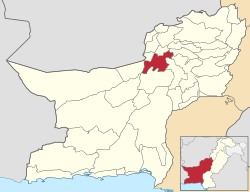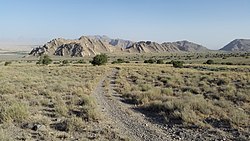Mastung District
This article needs additional citations for verification. (May 2012) |
Mastung District
ضلع مستونگ | |
|---|---|
Top: Mountains near Dasht Bottom: Koh-i-Chiltan | |
 Map of Balochistan with Mastung District highlighted | |
| Coordinates: 29°45′N 67°00′E / 29.750°N 67.000°ECoordinates: 29°45′N 67°00′E / 29.750°N 67.000°E | |
| Country | |
| Province | |
| Division | Kalat |
| Established | 1991 |
| Headquarters | Mastung |
| Government | |
| • Type | District Administration |
| • Deputy Commissioner | N/A |
| • District Police Officer | N/A |
| • District Health Officer | N/A |
| Area | |
| • Total | 3,308 km2 (1,277 sq mi) |
| Population (2017)[2] | |
| • Total | 265,676 |
| • Density | 80/km2 (210/sq mi) |
| Time zone | UTC+5 (PST) |
Mastung District (Balochi: مستونگ; Urdu: ضلع مستونگ) is a district located in the northwest of Balochistan province, Pakistan. Prior to its creation as a separate district in 1991, Mastung was part of Kalat District.[1]
Administration[edit]
The district consists of three Tehsils:[3]
Prior to 2006, within these there were 12 union councils: Khadkocha, Ghulam Parenz, Karez Noth, Mastung-1, Mastung-2, Sorgaz, Dasht, Isplinji, Kanak, Shaikh Wasil, Kardigap and Soro. In 2006, one additional union council formed with the name of Alizai, bringing the total union councils to 13.
Demographics[edit]
At the time of the 2017 census the district had a population of 265,676, of which 137,504 were males and 128,169 females. Rural population was 230,679 (86.83%) while the urban population was 34,997 (13.17%). The literacy rate was 39.66% - the male literacy rate was 49.69% while the female literacy rate was 28.92%. 775 people in the district were from religious minorities.[2]
At the time of the 2017 census, 85.93% of the population spoke Brahui, 8.00% Balochi and 3.02% Pashto as their first language.[2]
Education[edit]
According to the Pakistan District Education Rankings 2017, district Mastung is ranked at number 74 out of the 141 ranked districts in Pakistan on the education score index. This index considers learning, gender parity and retention in the district.
Literacy rate for 2014–15 of population 10 years and older in the district stands at 59% whereas for females it is only 38%.[4]
Post primary access is a major issue in the district with 79% schools being at primary level. Compare this with high schools which constitute only 8% of government schools in the district. This is also reflected in the enrolment figures for 2016–17 with 15,842 students enrolled in class 1 to 5 and only 642 students enrolled in class 9 and 10.
Gender disparity is another issue in the district. Only 36% schools in the district are girls’ schools. Access to education for girls is a major issue in the district and is also reflected in the low literacy rates for females.
Moreover, the schools in the district lack basic facilities. According to Alif Ailaan district education rankings 2017, the district is ranked at number 107 out of the 155 districts of Pakistan for primary school infrastructure. At the middle school level, it is ranked at number 115 out of the 155 districts. These rankings take into account the basic facilities available in schools including drinking water, working toilet, availability of electricity, existence of a boundary wall and general building condition. 4 out of 5 schools do not have electricity in them. More than half the schools lack a toilet and 1 out 3 schools do not have a boundary wall. 3 out of 5 schools do not have clean drinking water.
Notable people[edit]
See also[edit]
- 2017 Mastung suicide bombing
- Mastung Valley
- Babri Tribe
References[edit]
- ^ a b PCO 2000, p. 1.
- ^ a b c "District Wise Results / Tables (Census - 2017)". www.pbscensus.gov.pk. Pakistan Bureau of Statistics.
- ^ Tehsils & Unions in the District of Mastung - Government of Pakistan Archived 2012-02-09 at the Wayback Machine
- ^ Pakistan Bureau of Statistics (2016). Pakistan Social and Living Standards Measurement Survey 2014-15. [online] Islamabad: Government of Pakistan, p.111. Available at: http://www.pbs.gov.pk/sites/default/files//pslm/publications/PSLM_2014-15_National-Provincial-District_report.pdf [Accessed 6 Aug. 2018].
Bibliography[edit]
- 1998 District census report of Mastung. Census publication. Vol. 99. Islamabad: Population Census Organization, Statistics Division, Government of Pakistan. 2000.
External links[edit]
- Webarchive template wayback links
- Articles needing additional references from May 2012
- All articles needing additional references
- Articles with short description
- Short description with empty Wikidata description
- Pages using infobox settlement with bad settlement type
- Coordinates not on Wikidata
- Articles containing Balochi-language text
- Articles containing Urdu-language text
- Commons category link is the pagename
- AC with 0 elements
- Mastung District
- Districts of Pakistan
- Districts of Balochistan, Pakistan


